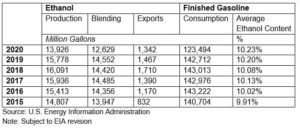 The Renewable Fuels Association reports year-end data from the Energy Information Administration (EIA) show both the impact of the COVID-19 pandemic and the resilience of the ethanol industry.
The Renewable Fuels Association reports year-end data from the Energy Information Administration (EIA) show both the impact of the COVID-19 pandemic and the resilience of the ethanol industry.
U.S. ethanol production fell to 13.93 billion gallons last year, down 1.85 bg, or 11.7%, from 2019. It was the lowest production level since 2013. The data indicate that domestic ethanol consumption was 12.63 bg (13.2% below the 2019 level and the lowest since 2009). Gasoline consumption in the United States totaled 123.49 bg, down 13.5%.
The implied ethanol blend rate—the average content of ethanol in gasoline—rose slightly to a record 10.23%. On a monthly basis, the blend rate slumped to 9.05% in April as petroleum prices plummeted and the price of renewable identification numbers (RINs) remained subdued after more than two years in which large-scale exemptions from the Renewable Fuel Standard had been granted to refiners. However, by November and December, the blend rate rose to record highs of 10.78% and 10.81%, respectively, as petroleum prices rebounded and RIN prices began strengthening after the election and no further refinery exemptions had been granted during the year.
RFA President and CEO Geoff Cooper also notes ethanol exports were relatively buoyant, “especially when export barriers and the impact of the pandemic on global fuel consumption are considered.”
The EIA estimated fuel ethanol exports at 1.34 bg, a decline of 8.5%. Exports were fairly strong to start the year but then were affected by a combination of trade barriers and pandemic-related declines in fuel consumption in key markets.

